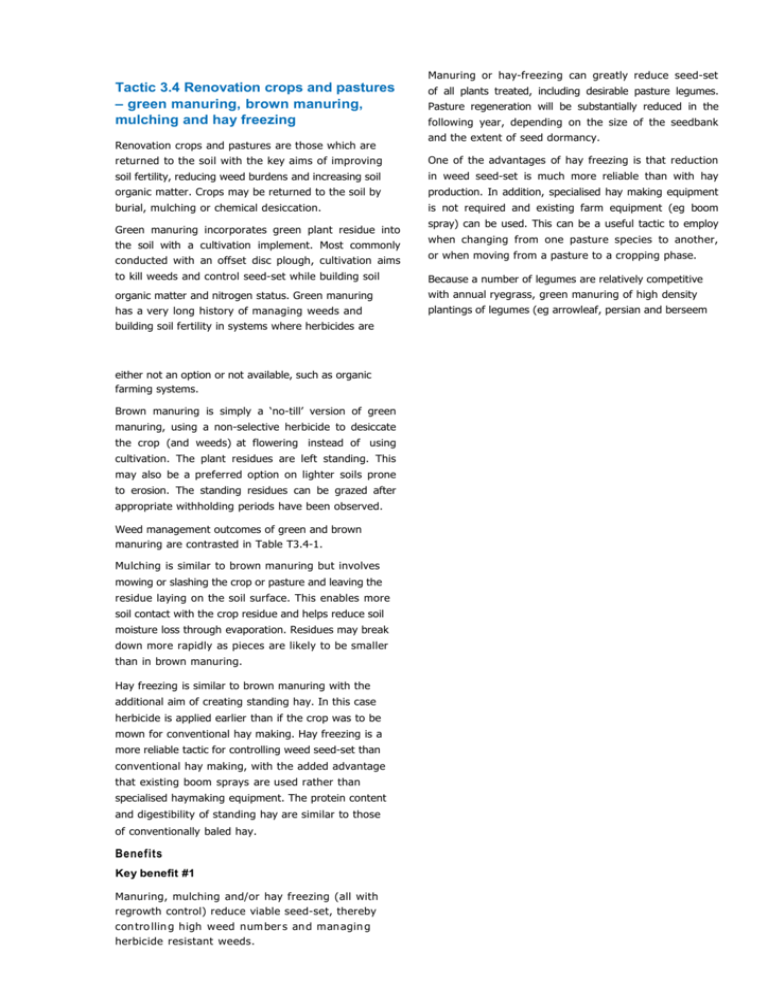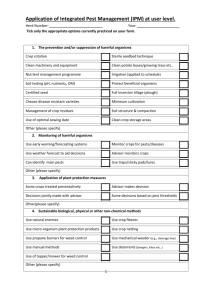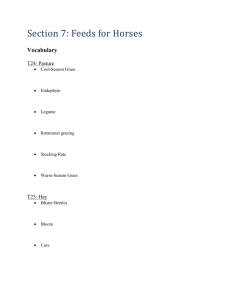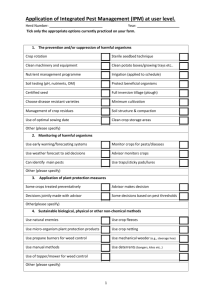Microsoft Word - Segment 001 of Tactic 3x
advertisement

Manuring or hay-freezing can greatly reduce seed-set Tactic 3.4 Renovation crops and pastures – green manuring, brown manuring, mulching and hay freezing Renovation crops and pastures are those which are of all plants treated, including desirable pasture legumes. Pasture regeneration will be substantially reduced in the following year, depending on the size of the seedbank and the extent of seed dormancy. returned to the soil with the key aims of improving One of the advantages of hay freezing is that reduction soil fertility, reducing weed burdens and increasing soil in weed seed-set is much more reliable than with hay organic matter. Crops may be returned to the soil by production. In addition, specialised hay making equipment burial, mulching or chemical desiccation. is not required and existing farm equipment (eg boom Green manuring incorporates green plant residue into the soil with a cultivation implement. Most commonly conducted with an offset disc plough, cultivation aims spray) can be used. This can be a useful tactic to employ when changing from one pasture species to another, or when moving from a pasture to a cropping phase. to kill weeds and control seed-set while building soil Because a number of legumes are relatively competitive organic matter and nitrogen status. Green manuring with annual ryegrass, green manuring of high density has a very long history of managing weeds and plantings of legumes (eg arrowleaf, persian and berseem building soil fertility in systems where herbicides are either not an option or not available, such as organic farming systems. Brown manuring is simply a ‘no-till’ version of green manuring, using a non-selective herbicide to desiccate the crop (and weeds) at flowering instead of using cultivation. The plant residues are left standing. This may also be a preferred option on lighter soils prone to erosion. The standing residues can be grazed after appropriate withholding periods have been observed. Weed management outcomes of green and brown manuring are contrasted in Table T3.4-1. Mulching is similar to brown manuring but involves mowing or slashing the crop or pasture and leaving the residue laying on the soil surface. This enables more soil contact with the crop residue and helps reduce soil moisture loss through evaporation. Residues may break down more rapidly as pieces are likely to be smaller than in brown manuring. Hay freezing is similar to brown manuring with the additional aim of creating standing hay. In this case herbicide is applied earlier than if the crop was to be mown for conventional hay making. Hay freezing is a more reliable tactic for controlling weed seed-set than conventional hay making, with the added advantage that existing boom sprays are used rather than specialised haymaking equipment. The protein content and digestibility of standing hay are similar to those of conventionally baled hay. Benefits Key benefit #1 Manuring, mulching and/or hay freezing (all with regrowth control) reduce viable seed-set, thereby c on tro llin g h igh w eed n um ber s an d m an agin g herbicide resistant weeds. Table T3.4-1 Contrasting green and brown manuring Weed management outcome Green manuring B r ow n m a nu r i ng Effectiveness in preventing seed return to paddock Depends on weed regrowth. A secondary cultivation is often needed to ensure Tall, dense or tangled herbage may interfere with herbicide coverage and complete success a ‘double knock’ treatment is advised to control survivors Ability of viable seeds to germinate Burial can induce dormancy in many species. Ideally, the manuring occurs before seeds are mature, so this should apply only to existing Herbicides at recommended rates generally have little effect on the ability of viable seeds to germinate seeds in the seedbank annual clovers) can reduce the seed-set and subsequent In Western Australia hay freezing serradella (cv Cadiz) germination of weeds in the following season (Table resulted in the lowest density of annual ryegrass and T3.4-2). The ‘no tactic’ treatment in the table indicates the highest wheat yields in the year after treatment, that field peas are a more competitive crop than lupins. compared to green manuring with an offset disc or The level of reduction of annual ryegrass will depend physical pasture topping with a mower. The average on the timing of tactical manuring and control of any regrowth. In Table T3.4-2 tactics are presented in reduction of in-crop weed numbers following green manuring, hay freezing and mowing of serradella chronological order of timing of activity. Green manuring pasture was 90.4% (Revell and Hudson 2001). takes place early in the season as yield can be more easily Key benefit #2 compromised for weed control benefit, and so the seed-set of annual ryegrass is effectively controlled. By contrast, the silage activity commences a little later in the season, with the result that some annual ryegrass can escape the tactic and set seed unless regrowth is controlled (107 weeds/m2 with no control of regrowth verses 1 6 weeds/m2 with grazing of regrowth) (Condon 2000). Haymaking was performed too late in the season to significantly reduce annual ryegrass seed-set, and Costs (income loss) from the renovation crop tactic can be o f f s et by im p r o ve d yiel d in s u bs equ ent cereal crops. Income loss from renovation crops can be mitigated in successive seasons by benefits such as increased wheat yields, improved grain quality and reduced weed control costs. Grazing competitive forage with high-value stock prior subsequent germinations were high. to imposing the treatment can also make a difference In a trial at Wongan Hills, Western Australia, Hoyle and instances outweigh and exceed the loss of income. to the first-year economics. These benefits may in some Schulz (2003) found that the reduction in annual ryegrass numbers in a wheat crop following green manuring was 94%, following brown manuring was 79% and following mulching was 82%. Table T3.4-2 Annual ryegrass germination (plants/m2) in autumn following green manuring, silage or hay production of forage break crops compared to pulses harvested for grain. Initial annual ryegrass population was 100 plants/m2 (Condon 2000) Weed management tactic Crop and treatment Annual ryegrass plants/m 2 Green manuring Vetch High density legume 44 29 Silage Vetch 44 High density legume High density legume, regrowth grazed Field peas Hay No tactic 107 16 401 High density legume 634 High density legume, regrowth grazed 549 Lupins harvested Field peas harvested 1,145 721 Key benefit #3 Key practicality #2 Patches of weeds in crops can be treated prior to hectic harvest time. Choice of renovation crop species will influence Weed infestations (resistant or otherwise) often begin in patches. Killing heavily weed-infested patches prevents production of viable seed and eliminates the risk of weed seed spread by the header. the com petit iven ess of th e renovation crop. Anderson (2005), quoting Hoyle and Schultz’s (2003) research investigating the proportion of total biomass that weeds represented within a renovation crop, stated that their results indicated that some crop Both green and brown manuring can be used for treating choices were far more effective at suppressing weeds weedy patches. The more practical option is to use than others (Table T3.4-3; see Agronomy 2 Improving herbicide, which is more effective where weed patches crop competition). are dense compared to individual weeds scattered through the crop. Table T3.4-3 Summary of weed biomass at flowering Patch treatment should only represent an initial in a renovation crop year averaged across six Western response to the weed problem. It should be followed Australian sites (Anderson 2005) by development and implementation of a weed management plan, using a range of tactic groups, Renovation to reduce seedbank numbers of targeted weeds. crop Whole-farm benefits Harvested peas 14 7–19 There are additional benefits from renovation crops: Renovated peas 11 1–18 Oats 3 0–7 Peas/oats mixture 3 1–7 Serradella 66 43–92 Manuring will have a beneficial effect on organic matter and soil nitrogen status. The benefit will be much greater if the crop or pasture being manured M ean annual ryegrass Range of % % of biomass has a high legume content. Hay freezing provides standing fodder for livestock. Less weed biomass should restrict weed seed production Green or brown manuring or hay freezing of annual forages can be used to manage other crop pests and diseases. but final levels of weed seed production in renovation Practicalities densities in wheat at Coorow, Western Australia, Key practicality #1 following various harvest treatments are provided in Manuring must be carefully timed to prevent seed-set and addition to the seed bank. Tactics aimed at reducing weed seed-set must be carried out when the most advanced target weed is at the mid-flowering to early seed-set stage. Green manuring needs to be carried out a little earlier crops and pastures will be dependent on the success of the manuring treatments. In-crop annual ryegrass Table T3.4-4. Table T3.4-4 Annual ryegrass density in wheat crop following green manuring of different crops, Coorow, Western Australia (Anderson 2005) Treatment in previous season plants/m 2 than brown manuring as seed can continue to develop and mature after the plant has been cut or incorporated Annual ryegrass Harvested lupin crop 106 Green manured lupins 32 Green manured oats/serradella mixture 29 Herbicide application for brown manuring and hay Green manured oats 19 freezing may be delayed until the soft dough stage of Green manured mustard 19 with a plough. A general guideline is to green manure before the end of the milk stage of the most mature seeds. the most mature seeds. The herbicide works quickly and prevents further seed development if used at this stage. Hay freezing for weed control is timed to match weed development and prevent seed-set rather than to optimise forage dry matter and quality, and is conducted earlier than conventional hay making. In general, renovation crop species that had good early vigour and were able to establish quickly (oats or oats/ peas mixes) were more effective at suppressing weed growth than those crop/pasture choices with slow early growth. The ability of the different renovation species to suppress weeds is summarised in Table T3.4-5 (Anderson 2005). Table T3.4-5 Summary of suppression ability of Excellent Good Fair Poor Ensure good coverage and penetration of herbicide, an d o bs er ve w ithh o ldin g per io ds w h en brow n manuring or hay freezing. Barley Canola Faba beans Clovers Oats Use an appropriate water volume, spray pressure and Lupins Medics Serradella nozzle to ensure the coverage and penetration of the different renovation crop species (Anderson 2005) Chickpeas herbicide is adequate to kill thick swards with large Wheat Lathyrus quantities of dry matter. Field peas Mustard Narbon beans Triticale Vetch Use registered herbicides and adhere to livestock grazing withholding periods when hay freezing. Key practicality #5 Key practicality #3 Economics in the year of manuring can be improved by planning the use of the tactic and Maximise seed kill by ensuring even and optimum head emergence of target weed. Prepare the paddock. Aim for an even head emergence by understanding and valuing subsequent benefits. of the target weed for effective hay freezing and brown Manuring or hay freezing a grain crop foregoes the manuring. Graze heavily in spring and remove the stock income from grain in that season. However, where other in sufficient time for recovery prior to treatment. tactics have failed and hay or silage are not suitable Where uneven head emergence is a problem, either because of mixed annual species or insufficient grazing pressure, heavier rates of glyphosate at full head emergence of the earliest flowering plants will effectively control seed-set of the entire sward. options, manuring or hay freezing do have merit. Treatment of weedy patches rather than a whole paddock is often easier to justify. Where herbicide resistance in key weeds is problematic, the economics of completely stopping seed-set in one or more years makes renovation crop tactics more favourable. Assess the economics of manuring on a rotational basis Use an autumn tickle at a later stage to encourage optimum seed emergence and reduction in weed seedbank. to capture ongoing benefits, as opposed to conducting Key practicality #6 single-year gross margins. The long-term benefits may M on itor an d m an age r egrow th . outweigh the loss of income suffered by sacrificing the crop. Monitor and control any regrowth or subsequent germinations. Control surviving weeds either with High-value stock, such as prime lambs, used to graze a glyphosate or paraquat, or graze to eliminate competitive forage crop prior to imposing the treatment subsequent weed seed-set. can make a big difference to the first-year economics. There will, however, be a penalty of nutrient removal by grazing animals. If grazing animals are not available, lupins, vetch or field peas may be a useful crop in which to conduct a green manure operation. These crops are reasonably inexpensive to establish, contribute a significant nitrogen boost and provide a useful disease break for subsequent cereal crops. Monjardino et al (2000) investigated the value of green manuring in the management of herbicide resistant annual ryegrass, and found that in some cases green manuring was a valuable tool while in others it detracted significantly from profitability. The value of green manuring generally increased with increasing densities of annual ryegrass infestation, but there was no value in green manuring where herbicides were still effective (ie no herbicide resistance). Ensuring excellent weed control in year 1, followed by green manuring, was a cost-effective technique that drove the seedbank to very low numbers. Key practicality #4 If glyphosate has been used for brown manuring, follow-up with heavy grazing, cultivation or paraquat. This will produce a reduction in weed seed-set while managing glyphosate and paraquat resistance. Whole-farm considerations There are multiple issues to consider when deciding when and how to use a renovation crop or pasture: Cultivation leads to losses of soil organic matter which needs to be considered when using green manuring. Brown manuring impacts positively on soil organic matter. Lighter textured soils may suffer excessive structural damage under green manuring. Brown manuring helps retain soil structure and surface cover. The number of tillage passes required by green manuring for a successful kill may be affected by soil moisture. The feed value and quantity of hay freezing fodder depend on the plant species and dry matter content of the area treated. Generally, feed value drops rapidly and the treated area needs to be grazed within a few months of spraying to gain most benefit. The protein content and digestibility of fodder following hay freezing deteriorate rapidly after rain, and the fodder suffers trampling losses over time. It does, however, provide and maintain better feed value than hayed-off standing pasture. Pastures treated with glyphosate have been observed to keep their digestibility for longer than those treated with paraquat (John Moore, pers. comm.). A glyphosate treated pasture in Western Australia would be expected to maintain good quality for 2 months after spraying. After approximately 3 months the quality of the feed in the treated paddock will be similar to that in untreated paddocks (Arkell 1995). Plan to graze soon after treatment to avoid the risk of forage quality loss due to weather damage. Strip grazing with an electric or movable fence can reduce trampling loss. Contributors John Moore, Vanessa Stewart and Steve Sutherland References Anderson, W. (2005). Renovation cropping – Can it help my weed problems? In Agricultural memo, Merredin Agricultural District, June 2005, vol 9, issue 4. Department of Agriculture, Western Australia. www.agric.wa.gov.au/pls/portal30/docs/FOLDER/IK MP/FM/merredin_200506. PDF Arkell, P. (1995). Productive pastures pay – a manual on pasture establishment for the above 700 mm rainfall zone. Bulletin 4302, Department of Agriculture, Western Australia. Condon, K. (2000). Forage Legumes – Profitable Break Crops for Dryland Cropping Rotations. NSW Agriculture, Orange. Hoyle, F.C. and Schulz, L. (2003). Restoration of paddock productivity through renovation cropping. In DWA 628 Trial Results, Appendix 3, GRDC Final Report DAW 628. Monjardino, M., Pannell, D.J. and Powles, S. (2000). The value of green manuring in the integrated management of herbicide-resistant annual ryegrass (Lolium rigidum). SEA working paper 00/11. www.general.uwa.edu.au/u/dpannell/dpap0011.htm Revell, C. and Hudson, C. (2001). Short-term pasture phases for weed control. In Agribusiness Crop Updates, Perth, Western Australia.






